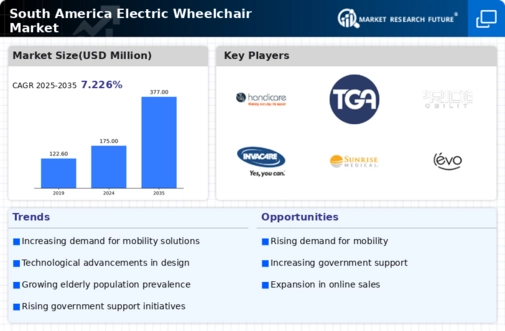Aging Population Dynamics
The aging population in South America is a crucial driver for the electric wheelchair market. As the demographic shifts towards an older age group, the demand for mobility solutions increases. In countries like Brazil and Argentina, the proportion of individuals aged 65 and older is projected to rise significantly, leading to a greater need for electric wheelchairs. This demographic trend suggests that the electric wheelchair market will experience substantial growth, as older adults often require assistance with mobility. Furthermore, the increasing prevalence of age-related health issues, such as arthritis and mobility impairments, further fuels this demand. The market could potentially see a growth rate of around 15% annually, reflecting the urgent need for accessible mobility solutions for the elderly population.
Rising Healthcare Expenditure
Healthcare expenditure in South America is on the rise, which positively impacts the electric wheelchair market. Governments and private sectors are investing more in healthcare services, leading to improved access to medical devices, including electric wheelchairs. For instance, Brazil's healthcare spending has increased by approximately 10% over the past few years, indicating a growing recognition of the importance of mobility aids. This trend suggests that more individuals will have access to electric wheelchairs, enhancing their quality of life. Additionally, as healthcare policies evolve to support better mobility solutions, the market is likely to expand. The increased funding for rehabilitation services and assistive technologies could lead to a projected market growth of 12% in the coming years.
Increased Awareness of Disability Rights
There is a growing awareness of disability rights in South America, which serves as a significant driver for the electric wheelchair market. Advocacy groups and non-governmental organizations are actively promoting the rights of individuals with disabilities, leading to increased visibility and demand for mobility aids. This heightened awareness encourages governments to implement policies that support accessibility and inclusion, further driving the need for electric wheelchairs. As public spaces become more accommodating, the market is likely to expand. The push for equal opportunities and improved living conditions for people with disabilities could result in a market growth rate of approximately 14% in the coming years, reflecting the societal shift towards inclusivity.
Urbanization and Infrastructure Development
Urbanization in South America is rapidly changing the landscape, impacting the electric wheelchair market. As cities expand and infrastructure develops, there is a growing need for accessible transportation solutions. Urban areas are increasingly focusing on creating inclusive environments, which includes the installation of ramps and accessible public transport. This trend suggests that the demand for electric wheelchairs will rise as more individuals seek mobility solutions that can navigate urban settings. Additionally, the development of smart cities may further enhance accessibility features, making electric wheelchairs more appealing. The market could potentially experience a growth rate of 16% as urbanization continues to reshape the mobility landscape.
Technological Integration in Mobility Solutions
The integration of advanced technologies in mobility solutions is transforming the electric wheelchair market in South America. Innovations such as smart controls, GPS navigation, and enhanced battery life are becoming increasingly prevalent. These technological advancements not only improve the functionality of electric wheelchairs but also enhance user experience. For example, the introduction of IoT-enabled devices allows users to monitor their wheelchair's performance and battery status in real-time. This trend indicates a shift towards more sophisticated mobility aids, appealing to a broader audience. As consumers become more tech-savvy, the demand for electric wheelchairs equipped with these features is expected to rise, potentially driving market growth by 18% over the next few years.

















Leave a Comment